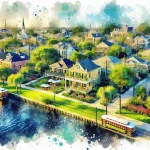Village de L’Est, a dynamic neighborhood in New Orleans East, exemplifies the city’s diverse cultural landscape. Spanning over 600 acres, this area has become a melting pot of communities, with a significant Vietnamese population contributing to its distinct character.
In This Article
TL;DR
- Village de L’Est is a culturally and historically significant neighborhood known for its thriving Vietnamese community and culinary scene.
- The area’s population comprises a mix of African American and Vietnamese residents, creating a vibrant cultural tapestry.
- Highlights include the Mary Queen of Vietnam Church, Vietnamese restaurants and markets, and community events celebrating the neighborhood’s heritage.
Historical Context and Development
Established in 1964, Village de L’Est initially offered affordable single and double houses, attracting residents seeking a suburban lifestyle. During the 1970s and 1980s, the neighborhood experienced a significant influx of Vietnamese immigrants, who found a welcoming community and established a thriving enclave known as “Versailles.”
Unlike many other New Orleans neighborhoods constructed on natural levees, Village de L’Est was built on drained marshland, leading to subsidence issues over time. However, the area has remained resilient, with residents actively working to address infrastructure concerns and preserve their community’s unique character.
Demographic Profile
Village de L’Est boasts a diverse population, with African Americans and Vietnamese residents comprising a significant portion of the community. This cultural diversity has enriched the neighborhood’s fabric, fostering an atmosphere where traditions intermingle and new customs emerge.
The population trends reflect broader demographic shifts in New Orleans, with an increasing number of young professionals and families seeking affordable housing and a sense of community. This influx has brought new energy and economic opportunities while highlighting the need for sustainable development and preserving the neighborhood’s cultural heritage.
Cultural and Culinary Highlights
Village de L’Est is a culinary destination, offering a unique fusion of Vietnamese and Southern flavors. The neighborhood’s Vietnamese restaurants and markets, such as the popular Vietnamese Farmers’ Market, attract visitors from across the city and beyond. Local favorites include bánh mì sandwiches, phở noodle soups, and Vietnamese coffee.
Cultural festivals and events are cornerstones of Village de L’Est’s identity. The annual Tet Festival, celebrating the Vietnamese Lunar New Year, is a vibrant celebration of traditional music, dance, and cuisine. Community organizations like the Mary Queen of Vietnam Church play a vital role in preserving and promoting the neighborhood’s cultural heritage.
Economic Landscape
While Village de L’Est has faced economic challenges in the past, the area is experiencing a resurgence of small businesses and entrepreneurial spirit. Local restaurants, shops, and services cater to the diverse needs of the community, providing employment opportunities and contributing to the neighborhood’s economic vitality.
Initiatives aimed at supporting small business development and attracting investment have been instrumental in revitalizing Village de L’Est’s commercial corridors. However, addressing income disparities and ensuring equitable access to economic opportunities remains a priority.
Community and Civic Engagement
Village de L’Est is home to a strong network of community organizations that play a crucial role in shaping the neighborhood’s future. Groups like the Village De L’Est Improvement Association actively advocate for residents’ interests, addressing issues such as infrastructure improvements and public safety.
Civic participation is highly valued, with residents actively engaging in local governance and decision-making processes. Community-led initiatives have tackled challenges ranging from environmental concerns to youth development programs, fostering a sense of ownership and pride.
Education and Institutions
Village de L’Est is served by several public schools, including Sarah T. Reed High School and Village de l’Est Elementary. These educational institutions play a vital role in shaping the future of the community by providing quality education and fostering a sense of belonging among students.
Local libraries and community centers offer educational programs and resources for residents of all ages, promoting lifelong learning and personal growth. Partnerships between these institutions and community organizations have led to initiatives aimed at enhancing educational outcomes and creating a supportive learning environment.
Infrastructure and Transportation
While Village de L’Est has faced challenges related to subsidence and aging infrastructure, ongoing efforts are underway to address these issues. The neighborhood’s road network and public utilities are undergoing improvements to ensure safety and accessibility.
Public transportation options, including bus routes and nearby New Orleans Regional Transit Authority (RTA) services, provide connectivity to other parts of the city. Efforts are also being made to enhance pedestrian and bicycle infrastructure, promoting sustainable transportation choices.
Environmental and Green Spaces
Village de L’Est is home to several parks and green spaces that contribute to the community’s quality of life. Bayou Michoud, a natural waterway running through the neighborhood, serves as a recreational area and a vital component of the local drainage system.
Environmental initiatives, such as community gardens and tree-planting programs, have been embraced by residents, promoting sustainability and environmental stewardship. These efforts enhance the neighborhood’s aesthetic appeal while fostering a connection with nature and commitment to preserving natural resources.
Challenges and Future Outlook
While Village de L’Est has made significant strides, the community continues to face challenges related to economic disparities, infrastructure maintenance, and environmental concerns. Addressing these issues will require collaborative efforts from residents, community organizations, and local authorities.
Despite these challenges, the future outlook remains optimistic. With its rich cultural heritage, strong community spirit, and ongoing revitalization efforts, the neighborhood is well-positioned to thrive. By embracing diversity, fostering economic opportunities, and prioritizing sustainable development, Village de L’Est can continue to be a vibrant and welcoming community for generations to come.






